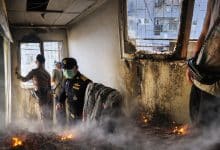Ashton Asoke condo’s fate lies in legal interpretation

The fate of the troubled Ashton Asoke condominium hinges on the interpretation of three pertinent sections of the prevailing law, as explained by the Bangkok Metropolitan Administration (BMA).
In a clarification of the circumstances surrounding the Ashton Asoke condominium dilemma, the Deputy Governor of Bangkok, Wisanu Subsompon highlighted the relevance of Sections 40, 41, and 42 of the Buildings Control Act 1979.
These sections could potentially provide a legal pathway to prevent the demolition of the condo following the Supreme Administrative Court’s decision last week. The court decision voided the construction permit of the fully completed 6 billion baht condo venture in Watthana district.
According to Section 40 of the act, appropriate officials are authorised to prevent the use of or restrict entry to a building that has been erected, altered, demolished or moved in violation of the law.
Section 41, nonetheless, provides building owners in breach of Section 40 with the opportunity to rectify the situation by acquiring the requisite permit within a given time limit, which can be extended. Wisanu noted over this past weekend that the proprietor of the upscale Ashton Asoke project could resubmit a request for a construction permit to the BMA adjacent to a concrete strategy for addressing the entrance quandary.
The BMA, he explained, could grant the project’s owners time to resubmit their petition, on the stipulation that it must have a minimum of one entrance with a width of 12 metres that connects to an 18-metre wide public road, adhering to the regulations, reported Bangkok Post.
The main entrance of the Ashton Asoke property connects to Asoke Road. However, a portion of the entryway space is under the management of the Mass Rapid Transit Authority of Thailand (MRTA), which used the area for the construction of an underground train station at the building’s fore.
This space, commandeered by the MRTA, does not constitute Ashton Asoke property, thus impeding the fulfilment of the requirement for a minimum of one 12-metre-wide entrance.
Wisanu also shed light on the intertwined legal complexities of Ashton Asoke’s case, referring to the implications of Section 42 of the Buildings Control Act yesterday. According to this provision, relevant authorities may mandate the partial or complete dismantling of a building if its owner does not take remedial steps or flatly refuses to rectify the issue.
The BMA’s public works department issued a directive to the Watthana district office, requesting the owner of the Ashton Asoke project to address the building’s problem, as specified in the act.
Wisanu hinted yesterday that if corrective actions delineated in Section 41 fail, the BMA would have no recourse but to enforce Section 42, which could spell the demolition of the Ashton Asoke condos.
Latest Thailand News
Follow The Thaiger on Google News:


























